As outdoor enthusiasts, we understand the pivotal role that a reliable and efficient outdoor tent plays in ensuring a comfortable and secure camping experience. Among the various features that contribute to the functionality of a tent, one aspect that stands out prominently is its waterproof design. In this article, we delve into the importance of outdoor tent waterproofing from a designer's perspective, exploring the technical aspects, innovations, and considerations that go into creating a tent capable of withstanding diverse weather conditions.
Understanding the Essence of Outdoor Tent Waterproofing
The primary purpose of an outdoor tent is to provide shelter and protection from the elements. Rain, in particular, poses a significant challenge for campers and hikers. Therefore, the emphasis on waterproofing cannot be overstated. A well-designed waterproof tent not only keeps the occupants dry but also ensures the longevity of the tent itself.
Waterproofing Materials and Techniques
Designing an effective waterproof tent requires careful consideration of materials and construction techniques. Modern outdoor tents often utilize advanced fabrics such as polyurethane-coated nylon or polyester. These materials offer a balance between durability, weight, and water resistance, making them ideal for various outdoor conditions.
Seam sealing is another critical aspect of waterproof design. Seams are potential weak points where water can penetrate. To address this, designers employ techniques like heat sealing or seam taping to create a watertight barrier. This meticulous attention to detail enhances the overall waterproof performance of the tent.
Innovations in Waterproof Technology
The outdoor industry has witnessed continuous advancements in waterproofing technology. Designers are constantly exploring new ways to enhance the water resistance of tents without compromising other essential features. One notable innovation is the development of hydrophobic coatings that repel water at a molecular level. These coatings not only prevent water absorption but also make the tent materials quick-drying, ensuring a hassle-free camping experience.
Ventilation Considerations
While waterproofing is crucial, it's essential to strike a balance with ventilation. Condensation inside the tent can be a common issue, especially in humid conditions. Designers address this challenge by incorporating strategic ventilation features. Mesh panels, adjustable vents, and well-placed openings facilitate air circulation, reducing the risk of condensation while maintaining a dry interior.
Durability and Longevity
A waterproof outdoor tent is an investment, and as such, durability is a key consideration for designers. The chosen materials, construction methods, and overall design impact the tent's ability to withstand prolonged use and exposure to the elements. A well-constructed waterproof tent not only provides immediate protection but also ensures that outdoor enthusiasts can rely on it for years to come.
User-Friendly Design
Designing a waterproof tent goes beyond technical considerations; it extends to user experience. Designers strive to create tents that are easy to set up, dismantle, and pack away. Intuitive designs with color-coded components, user-friendly instructions, and efficient packing systems contribute to a positive camping experience.
Versatility for Various Environments
Outdoor adventures take enthusiasts to diverse environments, each with its unique challenges. A well-designed waterproof tent should be versatile enough to adapt to different conditions. Whether it's a rainy weekend in the mountains or a humid coastal camping trip, a tent's waterproofing should instill confidence in users, knowing that they are prepared for whatever nature throws their way.
Environmental Considerations
In the pursuit of outdoor adventures, it's crucial to consider the environmental impact of our gear. Designers are increasingly incorporating eco-friendly materials and sustainable practices in the production of outdoor tents. From recyclable fabrics to responsible manufacturing processes, designers are aligning their creations with the principles of environmental stewardship.
Conclusion
In conclusion, the importance of outdoor tent waterproofing cannot be overstated when it comes to ensuring a positive and comfortable camping experience. From the careful selection of materials to innovative construction techniques, designers play a crucial role in creating tents that stand up to the challenges of the great outdoors. A well-designed waterproof tent not only protects against the elements but also contributes to the overall enjoyment and success of any outdoor adventure. As technology continues to advance and the demand for reliable outdoor gear grows, designers will undoubtedly continue to push the boundaries of what is possible in creating functional, durable, and waterproof tents for the modern adventurer.








